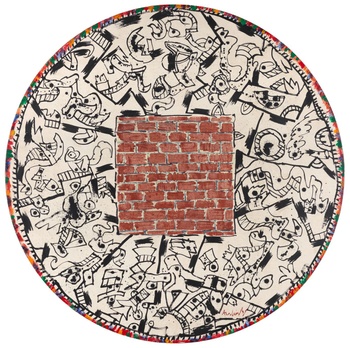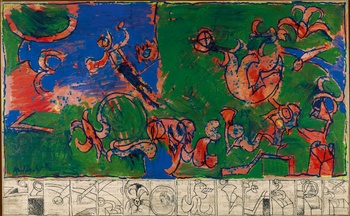Last year, the Brussels-born artist Pierre Alechinsky turned 93. Once an avant-gardist with CoBrA, he won the international art prize Praemium Imperiale in 2018 and all the while he remained devoted to the brush. His beloved Royal Museums of Fine Arts will now host an exhibition dedicated to his work on paper.
© Courtesy of the artist / Photo: André Morain
| Pierre Alechinsky: Passerelle [II] (1986)
With more than 150 drawings, watercolours, etchings, lithographs and paintings, the exhibition “Carta Canta” wants to show how, in Alechinsky's colourful and imaginative universe, capricious (calli)graphic experiments and swirling figuration have been making the paper sing for seven decades by now. Carta Canta was already the title of a portfolio of ten engravings that the artist published in 1978 and which form part of the Royal Museums of Fine Arts' (RMFAB) extensive collection of works on paper.
“His work forms a universe of paper,” says director of the Royal Museums of Fine Arts Michel Draguet, who believes that Alechinsky unites the Eastern style with American monumentality. “Glued or joined paper; old paper whose obsolete reality is slowly dying out... With a line, a spot, a movement, Pierre Alechinsky tells us who he is, where he comes from and where our gaze will lead us.”
ALECHINSKY MUSEUM?
The actual reason for this exhibition is a new donation of 45 works by Alechinsky to the Royal Museums of Fine Arts, which now have a total of 270 drawings, paintings and prints by the artist. Thus, together with Centre Pompidou in Paris, the Royal Museums are the largest conservators and advocates of Alechinsky's oeuvre.

© RMFAB, Brussels / Courtesy of the artist | Photo: Cedric Verhelst
| Pierre Alechinsky: Rue des Mimosas (2008)
The good relationship between Alechinsky and the RMFAB started back in 1955, when the Royal Museums purchased the oil painting Migration, which marked not only Alechinsky's crossing from Brussels to Paris, but also the conclusion of his CoBrA adventure and his switch from oil to acrylic paint. The Royal Museums exhibited a previous donation of around 120 drawings in 1973, followed by exhibitions in 1978 and 1988, the latter in collaboration with the Guggenheim Museum in New York. In 2007, the RMFAB celebrated its eightieth anniversary with the major retrospective “Alechinsky from A to Y”.
Draguet's dreams for the future stretch even further. “This exhibition sketches, through a selection, an oeuvre that soon will be a cornerstone of our cultural heritage, just like that of Magritte. In my view, it is a first step towards what could one day form the basis of a museum that would be to Pierre what the Magritte Museum is to René.”
ORANGE PEEL
Pierre Alechinsky has based himself in Bougival near Paris since the mid-1960s, but was born in Sint-Gillis/Saint-Gilles in 1927. He studied illustration and typography from 1944 at the École Nationale Supérieure des Arts Visuels founded by Henry van de Velde at La Cambre. In 1947, he began to paint and joined La Jeune Peinture belge (The Young Belgian Painters).
This exhibition is a first step towards what could one day form the basis of a museum that would be to Pierre what the Magritte Museum is to René
After a first solo exhibition, he and Christian Dotremont became some of the Belgian driving spirits behind the experimental and outspoken CoBrA movement with Danish, Belgian and Dutch artists. With his wife Micky and his colleagues Olivier Strebelle and Reinhoud, he also founded the Ateliers du Marais in Brussels. When CoBrA formally ended in 1951, Alechinsky left for Paris, but it was a trip to the Far East in 1955 that was to have a lasting influence on his work. There, he became acquainted with Japanese calligraphy and with acrylic paint as used by the Chinese-American artist Walasse Ting (1929-2010), whom he had met in Paris, and who taught him how to paint in this way by laying a canvas or paper on the ground and manoeuvring around it with a brush in his hand.
This is how some of Alechinsky's characteristic processes developed, such as the 'margin notes' that he makes on a strip in the margin of the central image. Or his 'narrative drawings', which are an extension of calligraphy, or which sometimes relate to poetry or prose by writers such as James Joyce or Julio Cortázar. In form, spirals, concentric circles appear along with related motifs such as the sun, the snake, mythical fable creatures or his typical “orange peels”. Colours alternate with his typical play with white and black.

© RMFAB, Brussels / Courtesy of the artist | Poto: Grafisch Buro Lefevre, Heule
| Pierre Alechinsky: Parfois c'est l'inverse (1970)
“Carta Canta” covers three levels of the museum, and also includes two monumental works of two by three in the main entrance hall. The visitor's guide provides information about the artist's life, work and techniques. Visitors can also take the opportunity to see “Aboriginalities”, a new exhibition dedicated to contemporary Aboriginal art. Having been closed for a year, the Fin-de-Siècle Museum has now also reopened and is showing works on paper by the Belgian artist Henri Evenepoel.
PIERRE ALECHINSKY: CARTA CANTA
> 1/8, Royal Museums of Fine Arts, www.fine-arts-museum.be
Pierre Alechinsky: Carta Canta
Read more about: Expo , Pierre Alechinsky , Carta Canta












_Lara_Gasparotto.jpg?style=W3sianBlZyI6eyJxdWFsaXR5Ijo3NX19LHsicmVzaXplIjp7ImZpdCI6ImNvdmVyIiwid2lkdGgiOjM2MCwiaGVpZ2h0IjoyNzAsImdyYXZpdHkiOiJjZW50ZXIiLCJ3aXRob3V0RW5sYXJnZW1lbnQiOnRydWV9fV0=&sign=706842bfed08f6d1c14457023fa2c3f8488095fa5cefd36d9869b795f1bb1447)